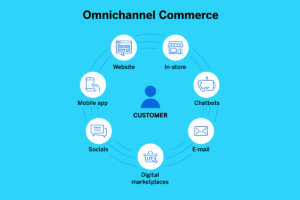What is omnichannel marketing?

Convenience and an excellent customer experience (CX) go hand in hand in the marketing world. Because of this, as a customer, you often have the greatest experience with a brand when it adopts an approach that is connected, clear, and consistent.
There are so many channels businesses use to communicate with their customers. Omnichannel marketing is engaging with consumers via the channels that they prefer, whether it be social media, text messaging, online, or in-person. Additionally, using an omnichannel strategy will help you effectively reach your clients where they are and provide high-quality service that suits their requirements and preferences.
If you’re interested in finding out more about omnichannel marketing, then read on as I’ll be discussing all you need to know in this article.
What is omnichannel?
Omnichannel marketing is the process of integrating and cooperating with the many channels that businesses use to communicate with customers, to produce a brand experience that is uniform across all engagement channels.
An organization’s marketing initiatives are combined via omnichannel marketing to provide a cohesive, unified brand experience across all platforms. This indicates that their images and graphics, message and tone, and any previous experiences a consumer may have had with them are all in harmony. One example of omnichannel marketing would be the option to purchase something online and pick it up in-store.
Multichannel vs Omnichannel
The primary distinction between multichannel and omnichannel marketing is in their respective goals. On the surface, they are very similar to each other. This is so because both tactics depend on using several channels.
To understand how, why, and when a consumer could connect with a brand, omnichannel marketing seeks to identify every channel that they may utilize. After this research is completed, the job at hand is to design a seamless, customized customer experience that satisfies every demand of the client in the most integrated and cohesive manner imaginable.
Multichannel marketing is a brand-centric approach as opposed to omnichannel marketing. Promoting a single, distinct brand message is the main goal of multichannel marketing, even if it also makes use of several media. Therefore, it is more about telling the consumer what the company wants them to hear and less about building a cohesive experience based on their requirements.
How to utilize an omnichannel marketing strategy
Although it may seem like a simple idea, omnichannel marketing is more complicated than it first seems. For many companies, a seamless omnichannel strategy is the ultimate goal. In addition, the execution of it is becoming more and more difficult as new channels, especially digital ones, appear.
To utilize an omnichannel marketing strategy effectively, you must follow the steps below:
1. Conduct research
Gathering information about both current and potential clients is the first stage in any digital or omnichannel transition. This will enable you to comprehend their motivations. In this context, data may be anything from the devices that clients use to the content types that they are most likely to interact with, the social media sites that they like, and the goods and services that they want to buy. It’s critical to comprehend all of their typical brand interactions as well as the actions that turn them into devoted patrons.
With the help of this kind of data, you can concentrate your efforts on linking and improving crucial touchpoints to make it easier for consumers to engage with your brand and make a purchase. Prioritize the platforms that your target clients prefer.
2. Analyze information
After gathering information on your prospects and clients, you must begin analyzing this information to find patterns. Finding the patterns and trends that will define the distinctive features of your omnichannel strategy is the primary goal.
3. Establish a brand identity
It is necessary to establish a set of omnichannel brand standards to ensure that all marketing platforms have a uniform appearance and feel.
Visuals, the tone of voice necessary for textual communication and advertising, social media rules, and how to use all of these in various circumstances should all be included in brand guidelines.
You’ll be prepared to begin implementing your brand rules across all the many components of your strategy, including content and applications, in-person and online. This is an essential component in creating a dependable client experience.
4. Monitor data and make adjustments to your plan
The first step was gathering client information, but the work didn’t end there. Creating procedures for ongoing data collecting is a component of your omnichannel strategy. You will be able to monitor crucial marketing metrics and KPIs to direct your future strategy in this way.
A constant flow of data and current reporting enable you to modify and advance your omnichannel strategy as needed with the help of meaningful, data-driven insights.
Conclusion
A positive brand experience will turn more potential consumers into devoted followers, and omnichannel marketing will help you with that. If you haven’t already incorporated it, then it’s time to seriously consider an omnichannel marketing strategy.





